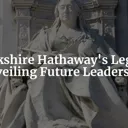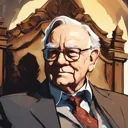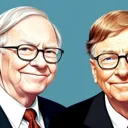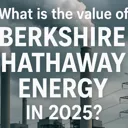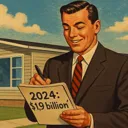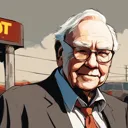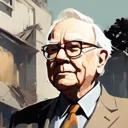Tags: Greg Abel / Warren Buffett / Shareholder-Meeting
This fanpage is not officially affiliated with Berkshire Hathaway: Disclaimer
Last Saturday, many of us felt a wave of emotion—goosebumps included—as Warren Buffett announced his retirement by the end of the year. It's impossible to fully express our gratitude to the man widely regarded as the greatest investor of all time ↗. With Buffett passing the CEO baton to Greg Abel, Berkshire Hathaway now stands at its most significant leadership crossroads since the 1960s. In this article, we examine Abel’s potential to fill some of the largest shoes in financial history.
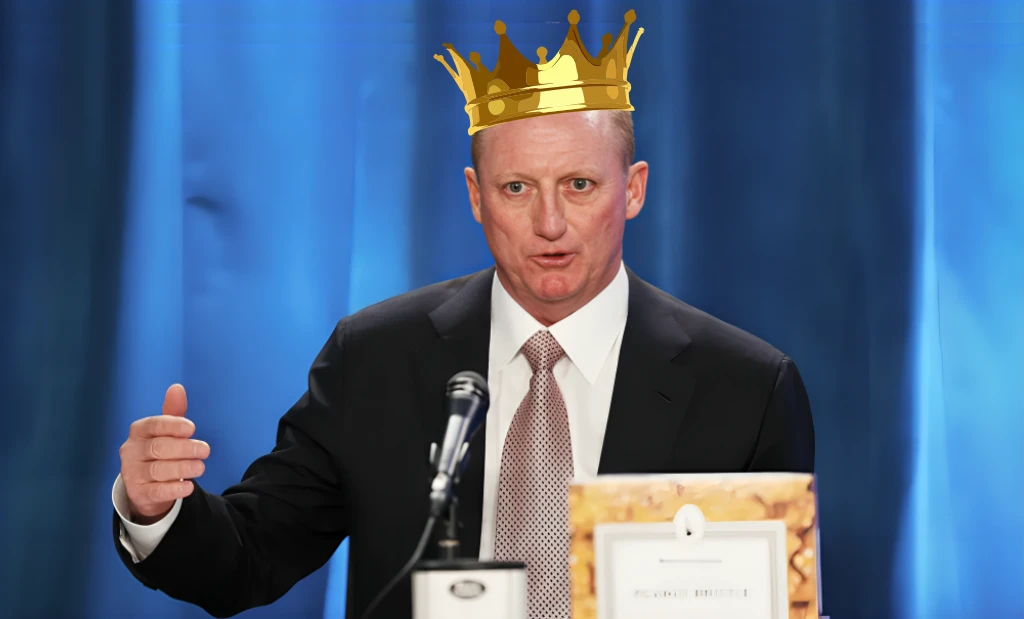
Introduction
The Berkshire Hathaway annual meeting in 2025 was supposed to be a celebration of continuity—a gathering of the faithful, a reaffirmation of the company’s unique culture, and, as always, a stage for the legendary Warren Buffett’s wit and wisdom. Instead, it became the site of a seismic announcement: Warren Buffett, at age 94, will step down as CEO at year-end, handing the reins to Greg Abel—a move that stunned even Abel himself, who learned of his elevation in real time alongside tens of thousands of shareholders and viewers 481. The moment was met with a thunderous standing ovation, but also with a collective intake of breath. After six decades of Buffett’s stewardship—transforming Berkshire from a struggling textile mill into a $1+ trillion conglomerate with nearly 400,000 employees and a fiercely loyal shareholder base—the question on every mind was simple: What happens now? 5.
In case you missed the historic moment:
The stakes could hardly be higher. Berkshire Hathaway’s stock has soared by 5,502,284% since 1965, dwarfing the S&P 500’s 39,054% return over the same period 1 ↗. Buffett’s era is rightly regarded as one of the greatest in business history—a testament to disciplined investing, decentralized management, and a culture that prizes integrity above all. Yet even the Oracle of Omaha cannot defy time. As he steps aside, the world’s most-watched succession drama enters its final act.
Greg Abel ↗, the Canadian-born executive who has quietly run Berkshire’s non-insurance empire for years, now faces the ultimate test: Is he fit to lead Berkshire into its post-Buffett era, or are there reasons for concern? Will he preserve the legacy, or will he chart a new course—by necessity or by design?
This article takes a dialectic approach, weighing both sides of the question. We’ll explore why Abel may be the right choice—offering continuity, operational expertise, and a deep understanding of Berkshire’s unique DNA. We’ll also examine the case for caution: What are the risks, and where might Abel fall short? To provide context, we’ll draw lessons from history—both the spectacular failures and the quiet triumphs of succession, from family dynasties like the Waltons and Johnsons to corporate giants like Apple and Disney 67.
For Berkshire shareholders, this is more than a change of guard. It is the company’s most significant leadership transition ever—a moment that demands clarity, context, and a healthy dose of caution. As the baton passes, the future of one of capitalism’s greatest experiments hangs in the balance.
The Making of Greg Abel
Gregory Edward Abel’s journey to the top of Berkshire Hathaway is a classic tale of humble beginnings, relentless drive, and quiet competence. Born in 1962 in Edmonton, Alberta, Canada, Abel was raised far from Wall Street’s glare. He earned a bachelor’s degree in accounting from the University of Alberta in 1984, then began his career as a chartered accountant at PricewaterhouseCoopers in San Francisco 25. The early years were marked by steady progress, not flashy headlines.
In 1992, Abel joined CalEnergy, a geothermal electricity producer with ambitions beyond its size. He quickly distinguished himself, navigating the company through a series of transformative acquisitions—including the pivotal purchase of MidAmerican Energy in 1999. That same year, Berkshire Hathaway acquired a controlling interest in MidAmerican, setting the stage for Abel’s ascent 2. By 2008, he was CEO of MidAmerican (later renamed Berkshire Hathaway Energy, or BHE), overseeing a sprawling portfolio of energy assets.
Abel’s management style is legendary among insiders. Described as a “workaholic” who “does more in every hour of every day than any person I’ve ever met,” Abel is known for his active, detail-oriented approach 5. He asks probing questions, expects rigorous thinking, and is unafraid to challenge assumptions. Chris Kelly, CEO of HomeServices of America, recalls that Abel’s inquiries “ensure you are thinking through directives and plans as a company” and that “you come away smarter from having a conversation with him” 5. Unlike Buffett’s famous “extreme delegation,” Abel is hands-on—a trait that may prove vital as Berkshire’s operations grow ever more complex.
Operationally, Abel has delivered. Under his leadership, BHE became a model of sustainable growth, serving over 11 million customers and generating about 10% of Berkshire’s total earnings by 2015 5. He spearheaded a $5.6 billion acquisition of Nevada’s NV Energy and directed over $5 billion into Iowa wind farms, making Berkshire’s Iowa utility the state’s dominant wind energy provider 5. Charlie Munger once predicted BHE would become “the biggest utilities business in the United States” thanks to Abel’s growth strategy and sustainability focus.
Since 2018, Abel has served as Vice Chairman of Berkshire’s non-insurance businesses, overseeing a vast empire that spans railroads (BNSF), retail (Dairy Queen), manufacturing, and more 2. He has worked closely with Buffett, absorbing the company’s culture and learning the art of capital allocation—a skill that will be tested as CEO.
Crucially, Abel has “skin in the game”. In October 2022, he purchased 168 Berkshire Hathaway Class A shares worth approximately $68 million, supplementing his existing holdings 2. This substantial personal investment aligns his interests with those of shareholders—a point not lost on Berkshire’s board or its famously vigilant investor base.
For quick reference, here is a summary of Greg Abel’s career milestones, management traits, and major achievements:
| Category | Description / Details |
|---|---|
| Birth | 1962, Edmonton, Alberta, Canada |
| Education | B.A. in Accounting, University of Alberta (1984); AICPA CPA |
| Early Career | PricewaterhouseCoopers (San Francisco) |
| Key Roles | CalEnergy (1992), CEO of MidAmerican/BHE (2008), Vice Chairman (2018) |
| Major Acquisitions | NV Energy ($5.6B, 2013); Iowa wind farms ($5B+ investment) |
| Operational Achievements | BHE: 11M+ customers, 10% of Berkshire earnings, wind energy leadership |
| Management Style | Workaholic, active, detail-oriented, probing questions |
| Berkshire Role | Oversees all non-insurance businesses; capital allocation |
| Personal Investment | $68M+ in Berkshire Class A shares; significant Class B holdings |
| Recognition | Horatio Alger Award (2018); praised by Buffett and Munger |
Greg Abel’s journey is one of substance over style—a steady rise built on results, not rhetoric. As he steps into the spotlight, shareholders and observers alike must ask: Are these the qualities Berkshire needs for its next chapter? The answer, as we’ll see, is nuanced—and the debate is just beginning.
Why Abel is fit: Continuity
For Berkshire Hathaway shareholders, continuity is not just comforting—it is a vital ingredient for the preservation of the company’s unique culture and performance. In this respect, Greg Abel’s promotion to CEO is less a leap into the unknown and more the next logical chapter in a meticulously crafted succession story.
Deep Berkshire Knowledge: Abel’s rise is rooted in decades of hands-on experience within the Berkshire ecosystem. Since joining through the acquisition of MidAmerican Energy in 1999, Abel has steadily climbed the ranks, ultimately overseeing all non-insurance operations—including iconic brands like BNSF Railway, Dairy Queen, and Benjamin Moore. His stewardship of Berkshire Hathaway Energy (BHE), one of the conglomerate’s most successful and sustainable businesses, is a testament to his operational prowess and deep understanding of the Berkshire playbook58. This is not an outsider parachuting in; Abel knows the culture, the people, and the businesses from the inside out.
Contrast With Failed Transitions: History is littered with cautionary tales of succession gone awry when outsiders or ill-prepared heirs take the helm. The McCain Foods saga, for example, saw a family feud erupt over succession, ultimately splitting the company and eroding value. Gucci’s transition led to infighting, financial distress, and the family’s eventual ouster. Reliance Industries, lacking a clear plan, devolved into a public sibling feud that fractured the business6. In stark contrast, Berkshire’s succession has been gradual, transparent, and deliberate—a model of best practice.
Operational Excellence: Abel’s record at BHE speaks volumes. Under his leadership, BHE became a powerhouse, serving over 11 million customers and generating about 10% of Berkshire’s total earnings by 2015. He spearheaded transformative investments—such as the $5.6 billion acquisition of NV Energy and over $5 billion in Iowa wind farms—demonstrating both growth acumen and a commitment to sustainability5. His ability to manage complex, capital-intensive businesses mirrors the demands of Berkshire’s sprawling empire.
Mentorship and Trust: Perhaps the most powerful endorsement comes from Warren Buffett himself, who has repeatedly described Berkshire as “so damn lucky” to have Abel ready to lead, assuring shareholders that “they shouldn’t worry about the future”5. Such unequivocal trust from Buffett—who has rarely offered such public praise—signals to investors that Abel is not just a capable manager but a true cultural steward.
Succession Planning: Unlike the chaos that followed Dhirubhai Ambani’s sudden passing at Reliance, Berkshire’s board and Buffett have executed a clear, public, and gradual succession process. Abel’s appointment was announced well in advance, and he has worked closely with both Buffett and the late Charlie Munger, absorbing their philosophy and approach65. This methodical transition minimizes uncertainty and ensures the company’s values and strategy remain intact.
Leadership Continuity: Abel’s years of close collaboration with Buffett and Munger have allowed him to internalize the Berkshire ethos—decentralization, long-term thinking, and integrity. He is not a stranger to the boardroom or the shop floor, and his presence provides reassurance of cultural continuity for employees and investors alike5.
Successful Succession Stories—A Table of Parallels 7:
| Company | Successor | Succession Approach | Parallels to Abel |
|---|---|---|---|
| Fidelity Investments | Abigail Johnson | Gradual, family-involved | Internal grooming, modernization |
| Walmart | Greg Penner | Family, professionalized | Blends tradition with new vision |
| Comcast | Brian Roberts | Generational, hands-on | Deep operational knowledge |
These examples show that planned, insider-led transitions—where successors are steeped in company culture and operations—tend to deliver stability and sustained performance. Greg Abel’s journey fits squarely within this tradition, suggesting that Berkshire Hathaway’s legacy is in safe, familiar hands.
Why Abel is fit: Change
Yet, for all the comfort that continuity provides, Berkshire Hathaway’s future may demand more than just preservation—it may require renewal. Here, Greg Abel’s appointment also represents a case for change, bringing fresh energy, perspective, and adaptability to a conglomerate facing new challenges.
Fresh Energy for New Challenges: Abel’s management style is notably more active and detail-oriented than Buffett’s legendary hands-off approach. As BHE’s leader, Abel was known as a “workaholic,” closely scrutinizing operations, asking tough questions, and driving performance5. This energy is timely: Berkshire now juggles nearly 400,000 employees, $347.7 billion in cash reserves, and a portfolio spanning dozens of industries54. The operational complexity and scale are unprecedented, and Abel’s intensity may be exactly what’s needed to keep the engine running smoothly.
Adaptability in a Changing World: The business landscape has shifted since Buffett’s prime. Competition for acquisitions is fiercer, private equity firms abound, and many traditional targets are now too small to move Berkshire’s needle48. Abel’s hands-on, adaptive approach could help Berkshire navigate this more dynamic environment—spotting risks, seizing opportunities, and ensuring subsidiaries act in the collective interest3.
Sustainability and Future-Proofing: Under Abel, BHE became an industry leader in renewables, directing billions into wind and solar infrastructure. This sustainability focus aligns Berkshire with global trends and regulatory shifts, future-proofing its utility businesses and enhancing its reputation as a responsible corporate citizen5.
Willingness to Act: Leadership experts stress that Abel should not simply mimic Buffett—“no one wants a replica.” Instead, he must make “bold, well-judged” moves and lead from his own strengths3. Abel’s readiness to act decisively, whether in acquisitions, divestitures, or operational turnarounds, is a valuable asset as Berkshire faces the pressure to deploy its vast cash reserves and address underperforming units.
Succession Timing—A Smoother Transition: Unlike the messy, often destructive transitions seen at Reliance, Gucci, or Viacom, Buffett’s decision to step down while alive and healthy allows for a supported, orderly handover6. Buffett remains as chairman, providing mentorship and continuity, but Abel will have the authority—and the responsibility—to shape Berkshire’s next era.
Modern Governance and Institutionalization: Abel’s approach reflects the demands of a modern conglomerate. He is expected to expand Berkshire’s corporate staff to manage both operational and investment responsibilities, introduce more robust risk management, and communicate relentlessly to calm any uncertainty among employees and investors48. This evolution from a founder-centric to an institutional leadership model is both necessary and overdue for a company of Berkshire’s scale.
Where Abel’s Approach May Diverge—Enumerated Examples:
- Operational Oversight: Abel is likely to be more involved in day-to-day management, ensuring subsidiaries are aligned and accountable.
- Capital Deployment: He may feel more pressure than Buffett to put Berkshire’s cash to work, potentially through high-profile acquisitions or new investments48.
- Staff Expansion: Abel is expected to build a larger corporate team to handle the growing complexity of the business4.
- Risk Management: His proactive stance may help Berkshire avoid pitfalls in areas like insurance (e.g., Geico’s telematics turnaround), railroads, or underperforming acquisitions.
- Stakeholder Engagement: Abel’s modern governance style emphasizes transparency and support for peers, helping to manage internal dynamics and external expectations3.
Greg Abel’s leadership is not just about honoring Berkshire’s past—it’s about equipping the company for the future. His blend of insider knowledge and appetite for change positions him to lead a “leadership leap” as much as a legacy handoff, ensuring Berkshire Hathaway remains resilient and relevant in a rapidly evolving world.
And now, let's play devil's advocate!
Why Abel might not be fit: The Devil’s Advocate
For Berkshire Hathaway shareholders, succession is not just a matter of continuity—it is a crucible that tests whether the next leader can match, or at least not diminish, the legacy of a once-in-a-century CEO. In the case of Greg Abel, the incoming chief executive, the optimism surrounding his operational prowess is tempered by legitimate questions. Playing devil’s advocate, let’s examine where Abel’s fit for the role is far from assured.
1. Investment Chops: The Missing Ingredient?
Warren Buffett built Berkshire’s empire through legendary capital allocation and shrewd stock picking. Greg Abel’s background, by contrast, is rooted in operations, not investing. He rose through the ranks at Berkshire Hathaway Energy, excelling at running and growing businesses, but he is not known as a stock picker or for making bold, market-beating investments 58. As Robert Miles, a close Berkshire observer, notes: “I don’t see anything in [Abel’s] background that would make him a good stock picker. That’s not where he got his chops” 8. In today’s Berkshire, with nearly $350 billion in cash and a sprawling investment portfolio, the ability to allocate capital wisely is not just a bonus—it’s a necessity.
2. Charisma and the Buffett Brand
Buffett’s unique blend of folksy wisdom, candor, and humor has built a reservoir of trust with shareholders, employees, and the world at large. His annual letters, marathon shareholder meetings, and deft handling of crises have become the gold standard for corporate communication. Can Abel, known for his work ethic and analytical rigor, inspire the same confidence and loyalty? As Bill Gates put it, “Warren’s so unique. I hope we have leaders like Warren in the future” 8. Abel’s more reserved style is untested on the global stage of shareholder psychology.
3. Succession Surprises: A Communication Red Flag?
The public announcement of Abel’s succession caught even Abel himself off guard—he learned of it at the same moment as shareholders, live on stage 48. While this speaks to Buffett’s penchant for drama, it also raises questions about internal communication and preparedness. If the incoming CEO is surprised by his own promotion, what does that signal about the transition process and the clarity of Berkshire’s succession planning?
4. The “Buffett Shadow”
The pressure to live up to the “Oracle of Omaha” is immense. Abel faces the risk of being either too cautious—paralyzed by the weight of Buffett’s legacy—or too eager to prove himself, making rash moves. Leadership experts warn that “no one wants a replica” 3. Yet, the gravitational pull of Buffett’s precedent could stifle innovation, making Abel hesitant to break new ground or, conversely, tempting him to overcompensate with headline-grabbing changes.
5. Deal-Making Doldrums
Berkshire’s acquisition landscape is far tougher now than in Buffett’s heyday. Recent major deals—like Kraft Heinz and Precision Castparts—have underperformed, and the pool of attractive, sizable targets has shrunk amid fierce competition from private equity and sovereign wealth funds 4. The strict acquisition criteria that once protected Berkshire from overpaying now risk leaving its cash hoard idle. Can Abel navigate this new terrain, or will he be forced into riskier or less lucrative deals?
6. Scale and Complexity: A New Kind of CEO
Berkshire Hathaway today is a $1 trillion behemoth with nearly 400,000 employees and hundreds of subsidiaries 5. The CEO’s job has shifted from being a master investor to an institutional manager—a fundamentally different skillset 8 ↗. Abel’s operational expertise is an asset, but the role now demands a blend of investment savvy, cultural stewardship, and strategic vision that few have ever demonstrated.
7. Historical Parallels: The Post-Legend Trap
History is littered with examples of successors struggling in the shadow of icons: Tim Cook after Steve Jobs at Apple, Bob Chapek after Bob Iger at Disney, and countless others. Even with the best intentions and preparation, the transition from legend to successor is fraught with pitfalls—some visible, others only revealed with time.
While Abel brings formidable strengths, these devil’s advocate concerns are not trivial ↗. They are the hard questions every shareholder should ask as Berkshire is about to enter its post-Buffett era.
Munger’s Invert: How Abel Could Fail
Charlie Munger, Buffett’s late partner, was famous for his mental model: “Invert, always invert.” ↗ To understand how Greg Abel could succeed, we must first invert the question and ask: How could he fail? Here are the most critical pitfalls—Abel’s “Seven Deadly Sins”—that could doom his tenure if not vigilantly avoided.
| Abel’s Seven Deadly Sins | Description | Historic Parallels |
|---|---|---|
| 1. Culture Disruption | Undermining Berkshire’s decentralized, hands-off ethos, alienating talented managers and eroding performance. | Post-Eisner Disney, where centralization stifled creativity. |
| 2. Acquisition Overreach | Chasing large, overpriced deals to deploy cash, repeating the mistakes of Kraft Heinz or Precision Castparts. | Kraft Heinz, Precision Castparts at Berkshire; AOL-Time Warner. |
| 3. Neglecting Capital Allocation | Focusing solely on operations and failing to empower investment deputies (Combs and Weschler), leading to mediocre returns. | Post-Jobs Apple’s early struggles with innovation; post-Redstone Viacom’s strategic drift. |
| 4. Poor Communication | Failing to match Buffett’s transparency and candor with shareholders, eroding trust and damaging Berkshire’s reputation. | GE under Jeff Immelt, where opaque communication led to shareholder mistrust. |
| 5. Bureaucratic Bloat | Building a bloated central staff, stifling the entrepreneurial spirit that defines Berkshire’s subsidiaries. | Post-McCain Foods, where succession disputes led to corporate malaise. |
| 6. Succession Mismanagement | Not preparing the next generation of leaders or mishandling his own succession, risking a power vacuum and internal strife. | Reliance Industries’ Ambani feud; Redstone’s CBS/Viacom saga. |
| 7. Fear of the Buffett Shadow | Succumbing to excessive caution or reckless overcompensation in an attempt to live up to Buffett’s legacy, paralyzing decision-making or inviting disaster. | Maurizio Gucci’s mismanagement post-Aldo; Chapek’s short-lived Disney tenure. |
Each of these sins is more than theoretical. History teaches us that even the most promising successors can falter if they lose sight of what made their organizations extraordinary—or if they fail to adapt to new realities. Abel’s challenge is not just to avoid these pitfalls, but to actively cultivate the judgment, humility, and boldness to lead Berkshire through uncharted waters.
Lessons from Succession: Successes and Failures
The transition of leadership at a global conglomerate is never a mere formality. History is replete with both inspiring handovers and spectacular collapses—each offering urgent lessons for Berkshire Hathaway shareholders as Greg Abel prepares to accept the baton from Warren Buffett. The stakes are high: succession can either preserve a legacy or unravel it in a matter of years.
Success Stories: The Power of Planning and Adaptation
Consider Fidelity Investments, where Abigail Johnson’s ascent to CEO in 2014 exemplifies a textbook transition. She succeeded her father, Edward Johnson III, not just by inheritance but by modernizing the business—diversifying products, embracing digital assets, and steering Fidelity to $11 trillion in assets and 40 million investors. Her story underscores the value of preparation, innovation, and continuity in safeguarding a family business’s future 7.
Walmart offers another case study in smooth succession. Greg Penner, the third chairman in over six decades, took the helm in 2015, praised for his technological savvy and global business experience. Penner’s leadership has balanced modernization with the preservation of core values, ensuring Walmart’s continued dominance in retail and e-commerce 7. The lesson: succession is not just about continuity, but about evolving with the times.
At CK Hutchison Holdings, founder Li Ka-shing’s gradual handover to his son Victor Li was marked by early planning and a phased transition. Li remains an advisor, providing stability and guidance as Victor steers the conglomerate through new challenges. This approach illustrates the importance of succession as a process, not an event—one that combines mentorship with empowerment 7.
Cautionary Tales: The Cost of Conflict and Chaos
The annals of business are equally rich with succession failures—often rooted in poor planning, family feuds, or lack of clear vision. At McCain Foods, sibling rivalry between Wallace and Harrison McCain led to a devastating split, outsider leadership, and the collapse of a once-great partnership. Wallace’s son Michael, despite his credentials, was blocked by family politics, and the company’s cohesion never recovered 6.
The saga of Gucci is a cautionary tale of how infighting and mismanagement can destroy a brand. After founder Guccio Gucci’s death, family members vied for control, culminating in betrayals, legal battles, and financial ruin. At one point, Gucci’s net worth turned negative, and the family ultimately lost control to outside investors 6. The lesson: legacy alone cannot substitute for unity and competence.
Reliance Industries in India suffered from the absence of a succession plan. Patriarch Dhirubhai Ambani’s sudden death triggered a public feud between his sons, Mukesh and Anil, fracturing the company and eroding value. Years of litigation and infighting followed, with the brothers’ rivalry playing out on the national stage and ultimately resulting in a split of the empire 6.
Key Takeaways for Berkshire Shareholders
- Preparation, transparency, and adaptability drive successful transitions.
- Family unity and a shared vision are critical in family-controlled firms—but so is the willingness to embrace outside talent when needed.
- Failure to plan or manage egos can destroy even the most robust businesses.
- Succession is not just about naming a successor, but ensuring they are empowered and equipped to lead.
As Berkshire Hathaway stands at its own crossroads, these lessons are more than academic—they are a roadmap for what to emulate and what to avoid as Greg Abel steps into the spotlight.
The Shareholder’s Perspective: What to Watch
For Berkshire Hathaway shareholders, Greg Abel’s ascension is not just a leadership change—it is a test of whether the firm’s legendary culture and performance can endure beyond the Buffett era. The coming years will require vigilance, discernment, and a clear-eyed focus on what matters most.
Capital Allocation: Discipline or Drift?
Buffett’s hallmark has been disciplined capital allocation—deploying cash only when opportunities meet Berkshire’s high bar. Abel inherits a cash hoard of hundreds of billions, and the temptation to “do something” will be immense, especially with investors and analysts scrutinizing every move. Will Abel maintain Buffett’s patience, or will he feel compelled to pursue deals or investments that dilute returns? As David Harden observes, Abel may face more pressure than Buffett ever did to put cash to work, particularly while Buffett remains as chairman 84.
Cultural Continuity: Decentralization vs. Centralization
Berkshire’s famed decentralized model has allowed its subsidiaries—from See’s Candies to BNSF—to flourish under local leadership. Abel has pledged to continue this hands-off approach, but as CEO, he may need to be more active in identifying risks and growth opportunities. Shareholders must watch for signs that headquarters is becoming too powerful, potentially stifling the entrepreneurial spirit that has defined Berkshire’s success.
Communication: Candor or Concealment?
Buffett’s annual letters and open communication have been a cornerstone of shareholder trust. Will Abel continue this tradition of radical candor, or will transparency wane as new leadership settles in? The tone and substance of Abel’s first communications will be closely scrutinized by investors seeking reassurance that the Berkshire ethos endures.
Leadership Team: Empowerment or Restructuring?
How Abel manages the roles of Todd Combs, Ted Weschler, and subsidiary CEOs will be telling. Will he empower these leaders to take on more responsibility, particularly in investment decisions, or will he centralize authority? The effectiveness of this team dynamic will shape Berkshire’s performance in the post-Buffett era.
Performance Metrics: Returns, Growth, and Discipline
Ultimately, numbers will tell the story. Shareholders should track Berkshire’s returns, business growth, and acquisition discipline. Will Abel maintain the company’s reputation for avoiding overpayment and sticking to its knitting, or will performance slip as the company adapts to new realities?
Market Reaction: Sentiment and Signals
The market’s response to Abel’s early decisions—especially in the first 12–24 months—will be a crucial barometer. Berkshire’s shares have recently traded at a premium to fair value, and any perceived misstep could trigger a re-rating. How investors and analysts interpret Abel’s moves will set the tone for his tenure 4.
Shareholder Red Flags
- Sudden, large acquisitions that lack Buffett’s trademark caution.
- Centralization of power and erosion of the decentralized model.
- Reduced transparency or less frequent communication.
- Departure of key leaders or increased turnover at subsidiaries.
- Declining returns or undisciplined capital deployment.
Shareholder Green Flags
- Continued patience in capital allocation, even amid pressure.
- Preservation of Berkshire’s decentralized, entrepreneurial culture.
- Clear, candid communication with shareholders and the public.
- Empowerment and retention of top talent, including Combs and Weschler.
- Sustained or improved performance metrics and acquisition discipline.
The transition from Buffett to Abel is more than a change of guard—it is a test of Berkshire’s DNA. Shareholders must remain vigilant and informed, watching not just for what Abel does, but how he does it. The next chapter will be written not by legacy alone, but by leadership in action.
Conclusion
Greg Abel’s elevation to CEO of Berkshire Hathaway marks a watershed moment in the company’s storied history—a transition that embodies both the promise of continuity and the necessity of change. As the logical heir, Abel brings decades of intimate knowledge of Berkshire’s sprawling operations, a proven track record of operational excellence, and a deep alignment with the company’s core values. His steady rise through Berkshire Hathaway Energy and stewardship of the non-insurance businesses have prepared him well to uphold the decentralized, integrity-driven culture that Warren Buffett so carefully cultivated 85.
Yet, Abel’s tenure is far from a mere legacy handoff. The challenges facing Berkshire today—ranging from deploying an unprecedented cash hoard, navigating a more competitive acquisition landscape, to adapting to evolving market dynamics—demand a leadership style that balances respect for tradition with strategic renewal. Abel’s more hands-on, detail-oriented approach and commitment to sustainability signal a readiness to lead a “leadership leap” as much as a legacy baton pass 84. This duality—continuity coupled with change—is the defining tension at the heart of his appointment.
History offers invaluable lessons for shareholders to consider. Successful transitions, such as those at Fidelity and Walmart, underscore the importance of clear succession planning, cultural stewardship, and adaptive leadership 7. Conversely, cautionary tales from Gucci, Reliance Industries, and others warn of the perils of poor communication, internal conflict, and failure to evolve6. For Berkshire, the deliberate and transparent nature of this succession—Buffett’s public endorsement, the board’s unanimous vote, and Abel’s years of close mentorship—provide a strong foundation on which to build.
Shareholders should approach this new chapter with a balanced perspective: vigilant but not alarmist. Berkshire’s institutional strength, its decentralized model, and Abel’s extensive experience are significant assets that bode well for stability. Moreover, Buffett’s continued role as chairman ensures a vital period of overlap and mentorship, softening the transition and preserving investor confidence 8. This overlap is more than symbolic—it is a strategic buffer that allows Abel to grow into the CEO role with Buffett’s guidance still accessible.
The stakes could hardly be higher. Berkshire Hathaway is not just one man’s legacy; it is a unique experiment in capitalism, a conglomerate whose resilience depends on the collective strength of its culture, leadership, and disciplined capital allocation. As shareholders, your role is pivotal: ask tough questions, monitor key performance indicators, and engage actively in annual meetings. Your scrutiny will help ensure that Abel’s leadership remains aligned with Berkshire’s enduring principles.
The future is inevitably uncertain. But with prudent stewardship, a willingness to innovate without abandoning core values, and a mindful avoidance of classic succession pitfalls, Berkshire Hathaway can continue to thrive well beyond the Buffett era. Greg Abel stands at the helm not only as Warren Buffett’s successor but as a leader poised to write the next chapter of a remarkable corporate saga—one defined by resilience, adaptability, and an unwavering commitment to excellence.
References
-
At 94, Warren Buffett to step down as Berkshire Hathaway CEO: His best advice for a successful career - www.cnbc.com ↩↩
-
Greg Abel - Wikipedia - en.wikipedia.org ↩↩↩↩
-
We asked career and leadership experts how to step into a big boss' shoes, in case Greg Abel needs some advice - www.businessinsider.com ↩↩↩↩
-
Berkshire Hathaway: 5 Key Takeaways From the Annual Meeting - www.morningstar.com ↩↩↩↩↩↩↩↩↩↩↩
-
Who is Warren Buffett’s successor at Berkshire Hathaway? 5 Things to know about Greg Abel - www.tatlerasia.com ↩↩↩↩↩↩↩↩↩↩↩↩↩↩↩↩↩
-
When Succession Goes Awry – Four Famous Examples of Failure - www.tharawat-magazine.com ↩↩↩↩↩↩↩↩
-
Drama-Free Succession: Ten Families Who Made it Work - www.tharawat-magazine.com ↩↩↩↩↩↩
-
Greg Abel’s Challenge: Lead Berkshire Into a New Era Without the Buffett Touch - www.wsj.com ↩↩↩↩↩↩↩↩↩↩↩↩↩↩

